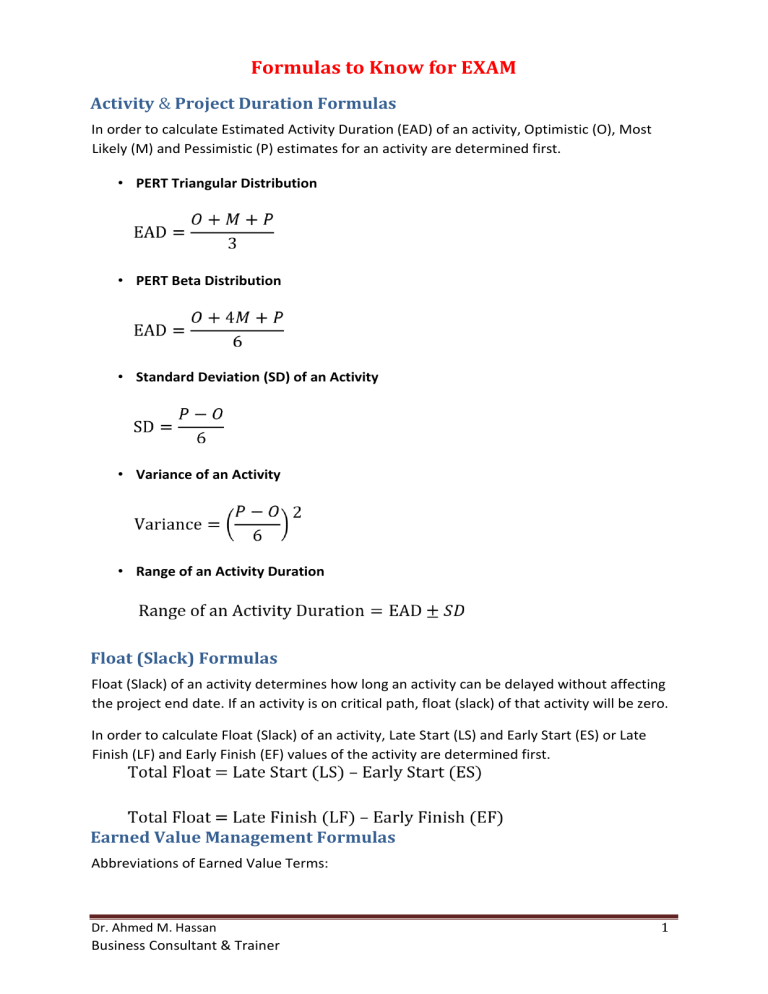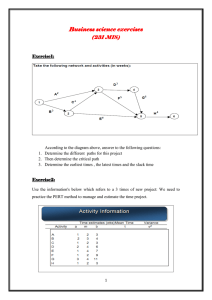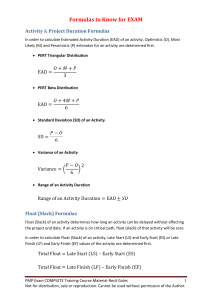
Formulas to Know for EXAM Activity & Project Duration Formulas In order to calculate Estimated Activity Duration (EAD) of an activity, Optimistic (O), Most Likely (M) and Pessimistic (P) estimates for an activity are determined first. • PERT Triangular Distribution • PERT Beta Distribution • Standard Deviation (SD) of an Activity • Variance of an Activity • Range of an Activity Duration Float (Slack) Formulas Float (Slack) of an activity determines how long an activity can be delayed without affecting the project end date. If an activity is on critical path, float (slack) of that activity will be zero. In order to calculate Float (Slack) of an activity, Late Start (LS) and Early Start (ES) or Late Finish (LF) and Early Finish (EF) values of the activity are determined first. Earned Value Management Formulas Abbreviations of Earned Value Terms: Dr. Ahmed M. Hassan Business Consultant & Trainer 1 Earned Value = EV Planned Value = PV Actual Cost = AC Cost Variance = CV Schedule Variance = SV Cost Performance Index = CPI Schedule Performance Index = SPI Budget at Completion = BAC Estimate to Complete = ETC Estimate at Completion = EAC Variance at Completion = VAC To-Complete Performance Index = TCPI • Cost Variance (CV) CV = EV − AC • Schedule Variance (SV) SV = EV − PV • Cost Performance Index (CPI) • Schedule Performance Index (SPI) • Budget at Completion (BAC) BAC is determined during cost management activities, in Determine Budget Process, in a project. BAC includes contingency reserves for activities and defines how much money will be spent during project in total. Dr. Ahmed M. Hassan Business Consultant & Trainer 2 • Estimate to Complete (ETC) ETC can be determined by re-estimation of the remaining works in a project or earned value (EV) of the accomplished activities can be subtracted from EAC to find ETC value. • Estimate at Completion (EAC) EAC value can be found by 3 different approaches using EV, SPI and CPI values. Approach #1: assumes that all future ETC work will be accomplished at the budgeted rate. Approach #2: assumes that cost performance achieved till now is expected to continue in the future. Approach #3: assumes that ETC work will be performed at an efficiency rate that considers both the cost and schedule performance indices. • Variance at Completion (VAC) Dr. Ahmed M. Hassan Business Consultant & Trainer 3 • To-Complete Performance Index (TCPI) TCPI can be calculated by two approaches. If there is not a new EAC value, 1st approach is used. If there is an EAC value, then 2nd approach is used. Approach #1: Approach #2: Present Value Formula There is time value of money and value of a future cash flow is less today than its amount in future. This is calculated by Present Value (PV) formula. Abbreviations of terms: Present Value = PV Future Value = FV Interest rate = r Number of periods = n Number of Communication Channels Formula If there are N stakeholders in an environment, following formula will give total number of communication channels between stakeholders in this environment. Dr. Ahmed M. Hassan Business Consultant & Trainer 4 Expected Monetary Value Expected Monetary Value (EMV) of an opportunity or threat is calculated by following formula: Point of Total Assumption Point of Total Assumption (PTA) is applicable only in Fixed Price Incentive Fee (FPIF) Contracts. Costs above PTA level are considered to be due to mismanagement. PTA is calculated by following formula. Dr. Ahmed M. Hassan Business Consultant & Trainer 5



